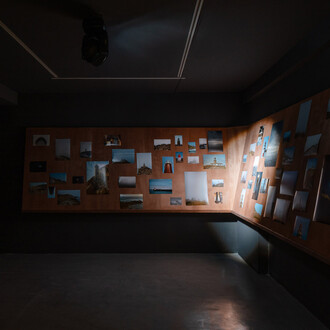NoguerasBlanchard is pleased to present Campos de texto (Text Fields), Ignacio Uriarte’s fifth solo exhibition in the gallery. Uriarte’s practice has developed around a particular semantic field: the artificial environment of the workplace. The artist finds a deep symbolism in the mundane objects and subtle actions associated the daily routine, making use of a wide array of everyday materials such as ballpoint pens, Excel spreadsheets, typewriters etc. The systematic repetition and serialization encapsulated in Uriarte’s works re-enact the myth of Sisyphus, a metaphor for modern man’s futile and repetitive labour, while they strike a delicate balance between the intensely handmade and the intensely mechanical. Adopting the square as a leitmotiv, a shape that is repeated and accompanies us throughout the exhibition, the works in Campos de texto —all of which oscillate somewhere between drawing and writing— respond to how humans structure and organise space, and to the drifts that occur within these processes. Thus in the series of drawings X-fields, made with a typewriter, we find ourselves before what appears to be an aerial view of fields, an image arising from a complex process of development and organisation. Like someone building a wall with stones of different sizes, Uriarte makes optimal use of space in X-fields, not so much looking for an image as for practical solutions while he repeatedly types the letter X. The image emerges during this process in the form of squares of varying sizes, somewhat like modular constructions that create larger volumes. The resultant image is the product of a rationalist process, a drawing that is written. These pieces offer a detailed reflection of the methodical and repetitive work necessary for their creation, with “the viewer in front of the workable to recreate the steps I have taken to execute an idea. It is both a drawing and a score.”
This concept of “writing drawings” is also present in the series Ventanas (Windows), made up of layers of parallel lines traced meticulously with an almost empty permanent marker. By creating his own mix of colors, Uriarte breaks with the palette offered by the manufacturer which has become standard in administrative writing. He thus becomes an alchemist who makes the marker express itself in a regular way in response to the whims of the object —manifest in variations of color and texture— allowing them to emerge and organizing them in the form of grids. Uriarte allows the viewer to enjoy this variation of colours in which the line disappears and becomes a deep and complex plotting structure that fades towards the centre, a clear reference to abstract painting that generates an atmospheric, unfocused image. While Ignacio Uriarte’s work is defined by his methodical and repetitive control of materials, process and their results, the works in this exhibition reveal slight variations presented in a regular way, like a musical chord. We also find this irregularity in the pieces made with typewriters, in how each X is physically typed on the paper, and in their recurrent use of red and black.
In the last series of works presented in the exhibition, Square Overlay, we find “squares that are released, that are liberated. The rules are broken, the order is broken, the Text Fields seem to have fallen at random, overlapping, blending and creating a third dimension and new geometric forms.” This ambivalence between the rule and its representation, and the will to break it by allowing chance to determine the compositions, gives rise to a “dynamic dance” that produces organic forms. More like a gesture that builds slowly, freeing itself with every keystroke.
Ignacio Uriarte (Krefeld, 1972). His work has been the object of solo exhibitions in institutions such as MARCO, Vigo; Mies van der Rohe Pavillion, Barcelona; Centre d’Art La Panera, Lleida; Sala Rekalde, Bilbao; Huarte Centro de arte, Pamplona; MUSAC, León; La Casa Encendida, Madrid; Kunstmuseum Reutlingen, Leopold Hoesch Museum, Düren; Kunstmuseum Bergisch Gladbach; Berlinische Galerie, Berlin; Deutsches Architekturzentrum, Berlin; Kunstverein Arnsberg; UMOCA, Salt Lake City; The Drawing Center, New York; Casa del Lago, Mexico City; Ladera Oeste, Guadalajara, Mexico; Perth Institute of Contemporary Arts in Australia.
He has participated in numerous group shows at Centro Botín, Santander; Fundación La Caixa, Barcelona; MACBA, Barcelona; Centro Párraga, Murcia; CAB Burgos; ARTIUM, Vitoria; Kaiser Wilhelm Museum, Krefeld; Kunstmuseum Bonn; Lenbachhaus, Munich; Museum Ludwig, Cologne; Kupferstichkabinett, Berlin; Haus der Kulturen der Welt, Berlin; Skulpturenmuseum Glaskasten, Marl; Kunsthalle Wien; Albertina Museum, Vienna; S.M.A.K., Gent in Belgium; Spike Island, Bristol; Fondazione Pistoletto, Biella; Triennale Design Museum, Milan; FRAC Lorraine, Metz; Yerba Buena Center for the Arts, San Francisco; Ludlow 38, New York; Pratt Manhattan Gallery, New York; University Museum, Alabany; MNBA Museo Nacional de Bellas Artes, Buenos Aires; Maison Hermès, Tokyo.
















